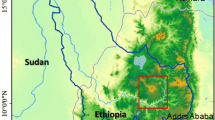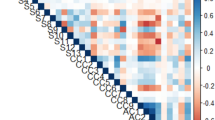Abstract
To propose specific adaptation strategies in the agricultural sector based on vulnerability to climate variability and climate change at the local level, we built a vulnerability index using an indicator tool at a fine spatial scale. This index was applied as a case study in the municipality of Guasave, Sinaloa, Mexico, at the basic census area (BCA) level. We used a total of 37 variables organized into three groups with equal weighting: exposure (13), sensitivity (13), and adaptive capacity (11). From the 20 rural BCAs located in the study area, eight were categorized as having very low vulnerability; five had low vulnerability; two had medium vulnerability because of the lack of basic services (sewers, water, and electricity) and a high rural population density; three had high vulnerability due to a high frequency of days with temperatures below 5 °C and the lack of basic services; and two had very high vulnerability, characterized by a high percentage of production units (PUs) with losses due to climate factors, a high rural population density, and a high frequency of days with temperatures below 5 °C. Approximately 50 % of the municipal rural population lives in BCAs vulnerable to climate change. This methodology allowed us to identify the most susceptible agricultural areas at the local level and the variables that require more attention so that we can propose adaptation strategies and minimize vulnerability due to climate change.


Similar content being viewed by others
References
Amoako F, William C (2012) Dependence on agriculture and ecosystem services for livelihood in northeast India and Bhutan: vulnerability to climate change in the tropical river basins of the upper Brahmaputra. Clim Chang. doi:10.1007/s10584-012-0573-7
Ayala L (2010) Metales pesados en agua y sedimentos del río Sinaloa. CIIDIR-SINALOA-IPN, Sinaloa
Bele MY, Tiani AM, Somorin OA, Sonwa DJ (2013) Exploring vulnerability and adaptation to climate change of communities in the forest zone of Cameroon. Clim Chang 119:875–889
Byjesh M, Kumar SN, Aggarwal P (2010) Simulating impacts, potential adaptation and vulnerability of maize to climate change in India. Mitig Adapt Strateg Glob Chang 15(5):413–431
Chhetri N, Easterling W, Terando A, Mearns L (2010) Modeling path dependence in agricultural adaptation to climate variability and change. Ann Assoc Am Geogr 100(4):894–907
CICESE (2013) Compuestos diarios en malla del CLICOM. Centro de Investigación Científica y de Educación Superior de Ensenada, Baja California. http://clicom-mex.cicese.mx/malla. Cited 10 Nov 2013
Collins TW, Grineski SE, Ford P, Aldouri R, Romo M, Velazquez G, Fitzgerald R, Lu D (2013) Mapping vulnerability to climate change-related hazards: children at risk in a US–Mexico border metropolis. Popul Environ 34:313–337
Domínguez MF, Borrell C, López R, Pastor V (2005) Mortality and socioeconomic deprivation in census tracts of an urban setting in Southern Europe. J Urban Health 82(2):225–236
Eakin H, Bojórquez LA (2008) Insights into the composition of household vulnerability from multicriteria decision analysis. Glob Environ Chang 18:112–127
El-Afandi G, Khalil F, Ouda S (2010) Using irrigation scheduling to increase water productivity of wheat-maize rotation under climate change conditions. Chil J Agric Res 70(3):474–484
FAO (2013) Climate-smart agriculture sourcebook. Food and Agriculture Organization of the United Nations, Rome
Gobierno del Estado de Sinaloa (2013) Plan estatal de desarrollo 2011–2016. http://sinaloa.gob.mx. Cited 10 Dec 2013
González LC, Torres F, Rodríguez HB, Rivera N (2013) Modelación de la calidad del agua en el dren el Burrión del distrito de riego 063, Guasave, Sinaloa, México. Paper presented at 11th Latin American and Caribbean Conference for Engineering and Technology. Cancún, México, 14–16
H. Ayuntamiento de Guasave (2013) Información de Guasave. http://www.guasave.gob.mx. Cited 10 Dec 2013
Heltber R, Osmolovskiy M (2011) Mapping vulnerability to climate change. The World Bank: Social Development Unit 5554
Hung H, Chen L (2013) Incorporating stakeholders’ knowledge into assessing vulnerability to climatic hazards: application to the river basin management in Taiwan. Clim Chang. doi:10.1007/s10584-013-0819-z
INEGI (2009a) Prontuario de información geográfica municipal de los Estados Unidos Mexicanos. Instituto Nacional de Estadística y Geografía. INEGI, Aguascalientes
INEGI (2009b) Censo agropecuario 2007, VIII censo agrícola, ganadero y forestal. Instituto Nacional de Estadística y Geografía. INEGI, Aguascalientes
INEGI (2010a) Censo de Población y Vivienda 2010, principales resultados por localidad. Instituto Nacional de Estadística y Geografía. http://www.inegi.org.mx/sistemas/consulta_resultados/. Cited 30 Jan 2014
INEGI (2010b) Manual de cartografía geoestadística. Instituto Nacional de Estadística y Geografía. INEGI, Aguascalientes
IPCC (2013) Summary for policymakers. In: Stocker TF, Qin D, Plattner K, Tignor M, Allen SK, Boschung J, Nauels A, Xia Y, Bex V, Midgley PM (eds) Climate change 2013: the physical science basis. Contribution of Working Group I to the Fifth Assessment Report of the Intergovernmental Panel on Climate Change. Cambridge University Press, Cambridge, United Kingdom and New York, NY, USA
IPCC (2014) Summary for policymakers. In: Field CB, Barros VR, Dokken DJ, Mach KJ, Mastrandrea MD, Bilir TE, Chatterjee M, Ebi KL, Estrada YO, Genova RC, Girma B, Kissel ES, Levy AN, MacCracken S, Mastrandrea PR, White LL (eds).Climate change 2014: impacts, adaptation, and vulnerability. Part A: global and sectoral aspects. Contribution of Working Group II to the Fifth Assessment Report of the Intergovernmental Panel on Climate Change. Cambridge University Press, Cambridge, United Kingdom and New York, NY, USA
Malik SM, Awan H, Khan N (2012) Mapping vulnerability to climate change and its repercussions on human health in Pakistan. Globalization and Health. http://www.globalizationandhealth.com/content/8/1/31. Cited 30 Jan 2014
Michel A (2009) Determinación de coliformes fecales y metales pesados en el Río Sinaloa. Universidad de Occidente, Sinaloa
Monterroso A, Conde C, Gay C, Gómez D, López J (2014) Two methods to assess vulnerability to climate change in the Mexican agricultural sector. Mitig Adapt Strateg Glob Chang 19(4):445–461
Moreno A, Becken S (2009) A climate change vulnerability assessment methodology for coastal tourism. J Sustain Tour 17(4):473–488
Ojeda W, Iñiguez M, González JM (2010) Vulnerabilidad de la agricultura de riego de México ante el Cambio Climático. In: Patiño C, Martínez P (eds) Atlas de vulnerabilidad hídrica en México ante el cambio climático. Efectos del cambio climático en los recursos hídricos de México, vol. III. Instituto Mexicano de Tecnología del Agua, 115-142
Ojeda W, Sifuentes E, Rojano A, Íñiguez M (2012) La adaptación de la agricultura de riego ante el cambio climático. In Patiño C, Martínez P (eds) Impacto del cambio climático en los recursos hídricos, vol. IV, Instituto Mexicano de Tecnología del Agua 65–113
Pandey R, Kumar S (2012) Climate vulnerability index—measure of climate change vulnerability to communities: a case of rural Lower Himalaya, India. Mitig Adapt Strateg Glob Chang 17(5):487–506
Ravindranath NH, Rao S, Sharma N, Nair M, Gopalakrishnan R, Rao AS, Malaviya S, Tiwari R, Sagadevan A, Munsi M, Krishna N, Bala G (2011) Climate change vulnerability profiles for North East India. Curr Sci 101(3):384–394
Salazar A, Masera O (2010) México ante el cambio climático: Resolviendo necesidades locales con impactos globales. Unión de Científicos Comprometidos con la Sociedad, A.C., México
Scholes R, Biggs R, Palm C, Duraiappah A (2013) Assessing state and trends in ecosystem services and human well-being. In: A manual for assessment practitioners. http://www.stockholmresilience.org/21/publications/artiklar/2011-01-28-assessing-state-and-trends-in-ecosystem-services-and-human-well-being.html. Cited 15 Jan 2013
SIAP (2013) Los municipios que generan más valor agrícola. Secretaria de Agricultura, Ganadería, Desarrollo Rural, Pesca y Alimentación. http://www.campomexicano.gob.mx/boletinsiap/014-e.html. Cited 15 Oct 2013
SIAP (2014). Cierre de la producción agrícola por estado. Secretaria de Agricultura, Ganadería, Desarrollo Rural, Pesca y Alimentación. http://www.siap.gob.mx/cierre-de-la-produccion-agricola-por-estado/. Cited Nov 2014
UNIATMOS (2014) Atlas climático digital de México. Universidad Nacional Autónoma de México. http://uniatmos.atmosfera.unam.mx/ACDM/servmapas. Cited 15 Dec 2013
Valenzuela T (2013) Evaluación del impacto antropogénico por metales pesados en plantas acuáticas y sedimentos del río Sinaloa. Universidad de Occidente, Sinaloa
Acknowledgments
We express our gratitude to INEGI’s Dirección General de Vinculación y Servicio Público de Información for the information provided on micro data from the 2007 Agriculture Census because this allowed us to achieve a more complete analysis of our work. We also thank the Mexican National Council for Science and Technology (CONACYT “Consejo Nacional de Ciencia y Tecnología”) for the doctoral scholarship provided for the first author.
Author information
Authors and Affiliations
Corresponding author
Rights and permissions
About this article
Cite this article
Ahumada-Cervantes, R., Velázquez-Angulo, G., Rodríguez-Gallegos, H.B. et al. An indicator tool for assessing local vulnerability to climate change in the Mexican agricultural sector. Mitig Adapt Strateg Glob Change 22, 137–152 (2017). https://doi.org/10.1007/s11027-015-9670-z
Received:
Accepted:
Published:
Issue Date:
DOI: https://doi.org/10.1007/s11027-015-9670-z




